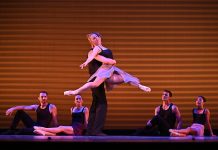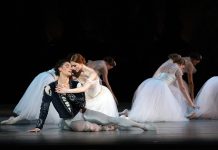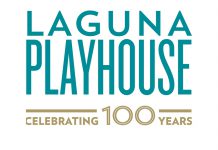Daniella Walsh/LB Indy
The Orange County Museum of Art’s anticipated 2010 California Biennial exhibition opened last Sunday and, this year, the anticipation appears justified,
OCMA’s curator Sarah Bancroft, hired by OCMA in 2008, has come up with 150 works that are thought provoking but not overwhelmingly so. Instead they offer whimsy, humor and the inevitable doses of psychic self-examination. There’s painting, sculpture, photography, installation, hybrids of the former and, for those with patience, video.
Bancroft’s choices fit into the current social-problem-saturated zeitgeist since audiences don’t encounter a depressing cacaphony of social commentary (enough of that on the outside) or conceptualist installations only a curator or moving crew could love.
Alex Israel’s room-sized installation “Property,” 2010, consists of 19 rented movie props ranging from a statue of Egyptian goddess Osiris to a magician’s black tophat. It engages since it’s homage to ordinary objects and mirrors the power of illusion and the ease with which it can be sold to the masses.
Instead of Orange County-based artists (save for Finishing School) Bancroft included a sizable reference to Orange County via Drew Heitzler’s “There Is Always Money in the Banana Stand,” 2010. It fills an entire gallery with images from the county’s history, from early orange groves, to now defunct sports teams, or that television show that most try to forget, as represented here by a mugshot of Mischa Barton.
A linear map of the county is filled with major cities, businesses operating here and in LA and with persons who lived here or who just briefly made their mark. The point is that the Orange Curtain is largely fiction—LA and Orange County have always been intertwined and the one thing that really separates the two is the 405 traffic snarl.
Bancroft says that she loves painting and has included several pieces, some noteworthy for their quality such as Patrick Wilson’s “Insomniac” or for their implied humor such as Andy Kolar’s “Six Deep.” Barcroft describes the Kolar series of paintings as humorous takes on abstraction.
Similarily, Tom Mueske’s “Untitled,” 2010, first repels and, on further examination, attracts for its colorful jumble of lines. At least his marks are to be taken in good fun—unlike Cy Twombly’s scribbles who are taken dead seriously and sold for sums to match.
Also noteworthy are Mari Eastman portraits of models such as “Carolina.” Using oil stick and glitter, she gives them a folk-arty appearance that contradicts the photoshopped perfection we have come to expect.
Speaking about send-ups: Rebecca Goldfarb’s installation titled “Traveling Through Darkness: Some Sense of the World Turned on When Faneur and Collector Meet for the Second Time,” 2010, seems to spoof Damien Hirst’s early medicine cabinets. Here, ordinary vintage and modern flashlights undergo metamorphoses into sex aids and less overt objects while others remain themselves.
On a more serious note, commentary on Iran’s political and social repression is surfacing in form of paintings like Taravat Talepasand’s “The Censored Garden,” 2008, which addresses institutionalized paranoia about women’s sexuality. She also decorated a MB5 motorcycle with flowers and symbols (“Angel of Iran, Dirty 50cc,” 1982-2009) to illustrate the deleterious effect roving bands of religious police have on ordinary citizens.
Bancroft also exhibits an eye for photography by choosing un-gimmicky shots with intelligent content: Katy Grannan’s series “Anonymous, Los Angeles,” 2008, is poignant in its portrayal of two women and a man who, while no longer young, hang on to the appearance that stylistically denotes their youth and happier times.
Lastly, in the realm of sculpture, Sherin Guirguis’ “Bein El-Quasrein” is the embodiment of pure beauty. Modeled after a Bedouin woman’s earring, the piece is exquisitely carved and assembled from layers of wood and metal. Ninety-six inches tall, it alone is worth the price of admission.
California Biennial runs through March 13 at the Orange County Museum of Art. 850 San Clemente Drive, Newport Beach; 949-759-1122; www.ocma.net.




